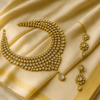The Glow of Tradition: What Is Zari and Why It Matters in Kanchipuram Sarees?

There’s a certain magic in the shimmer of a zari saree—an ethereal glow that catches the light and the eye, instantly evoking grace, grandeur, and timeless beauty. In the world of Indian textiles, zari is more than just metallic thread; it is heritage woven into every inch of fabric. Among the many handwoven marvels of India, kanchipuram sarees stand apart for their intricate zari artistry, where every border, motif, and pallu tells a story in gold or silver thread. At Yaalika, we celebrate this rich legacy by curating authentic zari sarees that blend traditional craftsmanship with modern elegance, offering a luminous ode to South India’s weaving heritage.
What Is Zari? The Thread That Shines

Zari is a fine metallic thread—traditionally made from real gold or silver—that adds a signature shimmer to Indian sarees. Woven into the fabric’s borders, motifs, and pallus, zari transforms a saree from simple drape to regal attire. Originally introduced during the Mughal era, zari was crafted by wrapping thin strands of precious metal around a silk or cotton core, a technique passed down through generations of master artisans.
While many weaving traditions across India—from Banarasi to Paithani—have embraced zari, its use finds an especially rich expression in Kanchipuram sarees. Here, bold temple borders and intricate patterns in gold zari or silver zari create stunning contrast against vibrant silk. These sarees are not just worn—they’re treasured. Whether it’s for a wedding or festive celebration, a zari work saree from Kanchipuram is a symbol of status, artistry, and cultural pride.
How Zari Is Made: The Process of Crafting Brilliance
The making of zari is a meticulous blend of tradition, technique, and artistry. Traditionally, a core thread—usually silk or cotton—is tightly wrapped with a flattened silver wire. This is then electroplated with gold, creating the classic gold zari. The result is a radiant, durable thread that’s skillfully woven into sarees to create shimmering motifs, ornate borders, and lavish pallus—commonly referred to as zari works.
Today, while real gold and silver zari are still crafted for premium weaves, more accessible alternatives like tested zari (silver-plated copper) and imitation zari (made from synthetic or copper wires) have gained popularity, especially in budget-friendly options like copper zari silk sarees.
Much of India’s zari production happens in Surat, Gujarat, which has been a historic hub for zari manufacturing for centuries. The artistry doesn’t stop at thread-making—skilled weavers in Kanchipuram breathe life into zari by embedding it into silk through time-honored handloom techniques, creating sarees that truly shine with heritage.
Real Zari vs Imitation Zari: How to Tell the Difference
When it comes to Kanchipuram sarees, understanding the difference between real zari vs imitation zari is essential—especially for those investing in bridal or heirloom pieces. Real zari is made from a pure silver base, often plated with gold, and then woven onto silk. It’s heavier, more durable, and develops a beautiful antique patina over time. These sarees, such as a silver zari pattu saree or a pure gold zari kanjivaram saree, can last generations when cared for properly.
On the other hand, imitation zari uses copper, tested zari, or even polyester-based threads that are merely gold- or silver-colored. While these threads mimic the look of real zari, they are significantly lighter, more affordable, and tend to wear out faster—making them ideal for casual or contemporary looks like copper zari sarees.
For bridal wear and ceremonial occasions, pure silk zari sarees woven with real zari remain the gold standard. Not only do they carry a sense of tradition and prestige, but they also represent an heirloom investment—one that can be cherished and passed down, retaining both its value and beauty over time.

Zari in Kanchipuram Sarees: The Heritage Connection
If zari is the soul of Indian sarees, Kanchipuram is its royal home. Revered for their opulence, Kanchipuram sarees have long been celebrated for their intricate use of zari—especially in borders and pallus. Traditional motifs like peacocks, temple borders, checks, and floral vines come alive in shimmering silver or gold zari, lending these sarees a timeless elegance.
The interplay of color and metallic sheen is iconic—think of a vibrant pink or green soft silk saree with zari-laden silver borders, or a rich maroon drape with bold temple designs crafted in gold thread. The beloved kanjeevaram silver zari silk saree is particularly cherished for its subtle sophistication, often worn for weddings, festive pujas, and formal events.
Whether it’s a classic silver border pattu saree or a more contemporary silk saree with zari, the craftsmanship and density of zari work in Kanchipuram weaves set them apart. The depth, detail, and durability of this art form continue to make these sarees a treasured part of every South Indian wardrobe and a statement of cultural pride.
The Role of Color: Copper, Silver & Modern Zari Tones
While traditional gold zari remains timeless, modern brides are increasingly gravitating towards fresh metallic tones like copper and silver zari. These contemporary choices bring a refined elegance to the classic Kanchipuram silhouette, especially when paired with muted or pastel hues. A copper colour saree with intricate motifs or a silver border saree on soft peach silk can feel both regal and refreshingly modern.
Pastel kanjivarams have become sought-after for pre-wedding events and receptions, with shades like lavender, rose gold, and sky blue beautifully complementing metallic zari. The lavender silver zari saree is a standout choice for brides who want understated glamour, while a blue saree with silver zari or pink silver zari saree creates a striking contrast that’s ideal for muhurtham ceremonies or bridal trousseau collections.
These evolving color palettes—while rooted in tradition—reflect the evolving tastes of today’s bride, blending heritage with high fashion in every thread.
Caring for Zari Sarees: Preserving the Glow
To ensure your zari silk saree retains its brilliance over time, proper care is essential. Always fold your saree along the fabric, avoiding sharp creases on the zari borders or motifs. Wrap it in a soft cotton or muslin cloth to protect the delicate threads from moisture and dust. Never store it in plastic, as this can cause the zari to oxidize.
Dry cleaning is the safest method for maintaining both the silk and the metallic threads, especially for heirloom pieces like silver zari pattu sarees with price value. Re-fold the saree occasionally to prevent permanent creases and air it out every few months.
With age, old zari may develop a natural patina, adding vintage charm—but careful handling can delay tarnishing and preserve its original glow for decades to come.
Yaalika’s Curation: Timeless Zari Meets Modern Grace
Each saree from Yaalika is more than just a garment—it’s a story woven with care, tradition, and elegance. Every thread reflects a deep respect for heritage, crafted to resonate with timeless beauty and personal meaning. We handpick bridal pattu sarees and soft silk drapes crafted by skilled Kanchipuram artisans, using both real and tested zari to suit every style and occasion. Our collection blends the grandeur of heritage with a touch of modern flair.
From the understated elegance of a lavender silver zari saree to the earthy richness of a copper zari soft silk saree, every piece reflects our dedication to quality and authenticity. Whether you're looking for a pure silk zari saree or a statement kanchipuram silver zari silk saree, Yaalika offers timeless beauty tailored for today’s bride.
Why Zari Is More Than Decoration
A zari saree is more than just shimmer—it’s a reflection of heritage, meticulous craftsmanship, and timeless cultural identity. From ceremonial elegance to everyday grace, zari continues to be a beloved element in Indian textiles, especially in the regal artistry of Kanchipuram weaves. Whether you're curating an heirloom wardrobe or choosing the perfect wedding pattu saree, zari adds unmatched richness and meaning.
Explore kanchipuram sarees online at Yaalika and discover handcrafted treasures that celebrate tradition with every gleaming thread.
-
Posted in
kanchipuram silk, premium silk sarees




